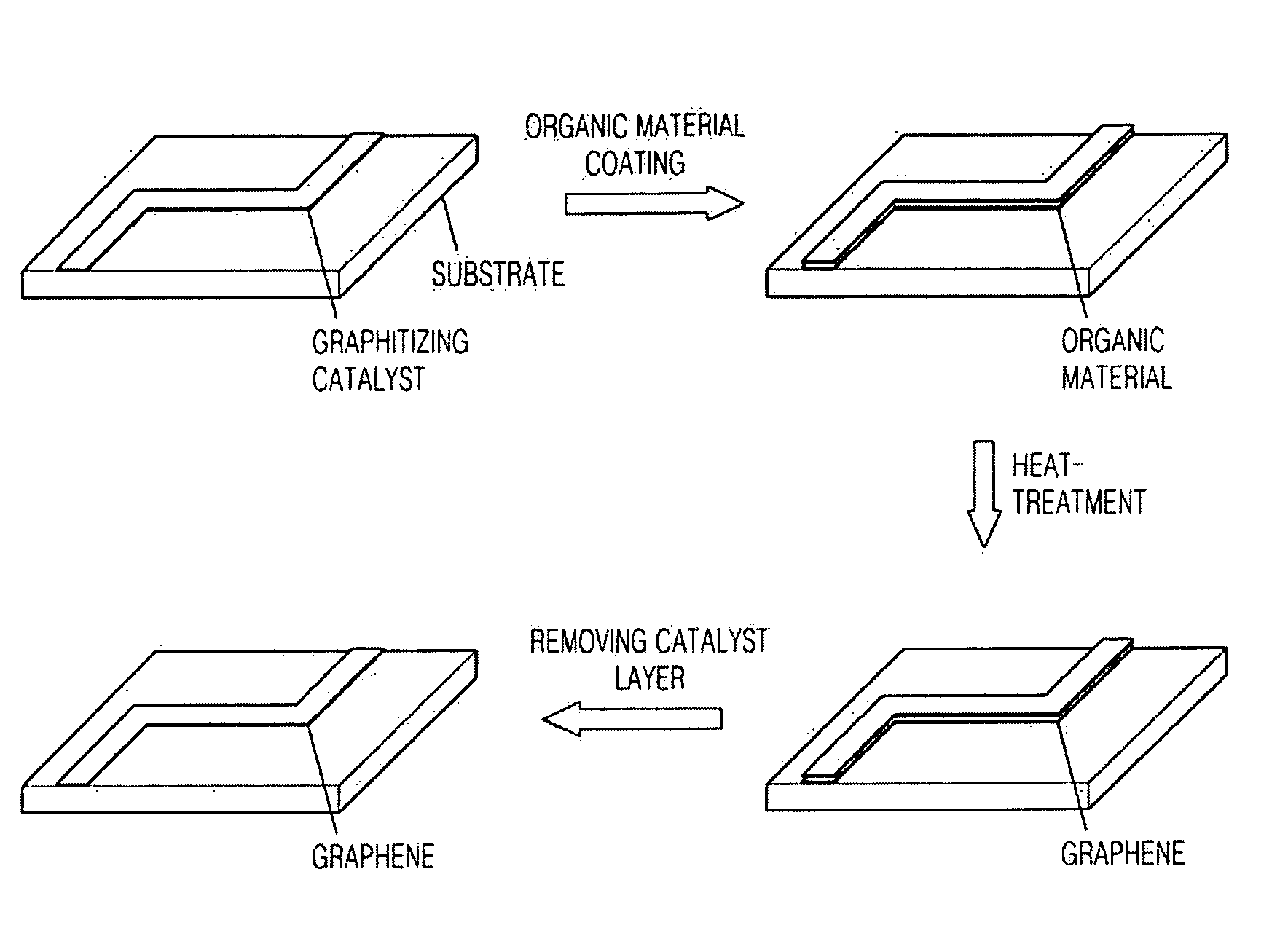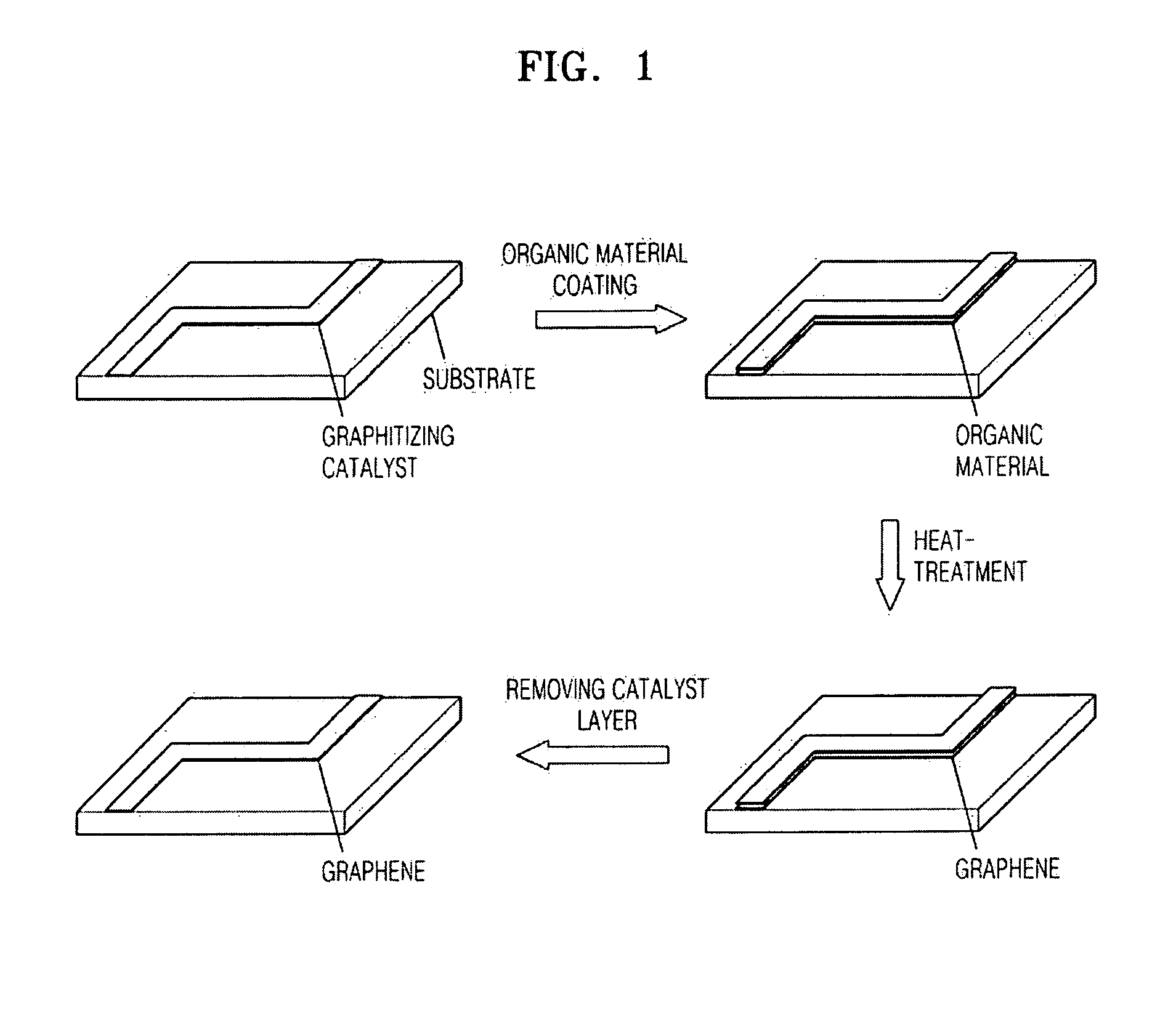Graphene pattern and process of preparing the same
a graphene pattern and graphene technology, applied in the field of graphene patterns, can solve the problems of inability to develop a simple process for separating single-walled carbon nanotubes, inability to economically and reproducibly prepare a large-area graphene sheet, and high cost of products made from carbon nanotubes which are similar to graphene sheets
- Summary
- Abstract
- Description
- Claims
- Application Information
AI Technical Summary
Benefits of technology
Problems solved by technology
Method used
Image
Examples
example 1
[0089]A photoresist (PR) patterning was formed on a 3 cm×3 cm silicon substrate on which 100 nm of SiO2 is coated, and Ni was deposited using sputtering to form a Ni high-precision pattern having a line width of 1 micron.
[0090]An oleic acid solution was separately prepared by dissolving oleic acid in chloroform to a concentration of 1 mg / ml. After water is added to a LB device, 50 μl of the oleic acid solution was dropped thereto. Then, a self assembled monolayer (SAM) was prepared using the LB device. The SAM formed of oleic acid was polymerized by radiating UV rays of a wavelength of 254 nm. The polymerized oleic acid SAM was transferred to the silicon substrate on which 100 nm of SiO2 is coated.
[0091]Then, the oleic acid-coated substrate was dried by heating at 60° C. for 12 hours in a vacuum atmosphere. The dried oleic acid-coated substrate was heat-treated in a furnace at 500° C. for 1 hour in a nitrogen atmosphere to obtain a substrate including a single-layered graphene sheet...
example 2
[0093]A substrate including a 4-layered graphene pattern was prepared in the same manner as in Example 1, except that the process of transferring the polymerized oleic acid SAM to the Ni pattern was repeated 4 times.
[0094]Then, the substrate on which the graphene pattern is formed was melted in 0.1 M HCl for 24 hours to remove the Ni thin film.
example 3
[0095]Ni was deposited on a 3 cm×3 cm silicon substrate on which 100 nm of SiO2 is coated using sputtering to form a Ni thin film.
[0096]An oleic acid solution was separately prepared by dissolving oleic acid in chloroform to a concentration of 1 mg / ml. After water is added to a LB device, 50 μl of the oleic acid solution was dropped thereto. Then, a self assembled monolayer (SAM) was prepared using the LB device. The SAM formed of oleic acid was polymerized by radiating UV rays of a wavelength of 254 nm. The polymerized oleic acid SAM was transferred to the silicon substrate on which 100 nm of SiO2 is coated. The process of transferring the polymerized oleic acid SAM to the substrate was repeated 4 times.
[0097]The substrate was partially heat-treated using e-beam to form a 4-layered graphene having a line width of 50 nm, and melted in 0.1 M HCl for 24 hours to remove the oleic acid SAM formed on the region on which graphene is not formed and the Ni thin film.
PUM
| Property | Measurement | Unit |
|---|---|---|
| temperature | aaaaa | aaaaa |
| thickness | aaaaa | aaaaa |
| boiling point | aaaaa | aaaaa |
Abstract
Description
Claims
Application Information
 Login to View More
Login to View More - R&D
- Intellectual Property
- Life Sciences
- Materials
- Tech Scout
- Unparalleled Data Quality
- Higher Quality Content
- 60% Fewer Hallucinations
Browse by: Latest US Patents, China's latest patents, Technical Efficacy Thesaurus, Application Domain, Technology Topic, Popular Technical Reports.
© 2025 PatSnap. All rights reserved.Legal|Privacy policy|Modern Slavery Act Transparency Statement|Sitemap|About US| Contact US: help@patsnap.com



